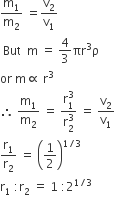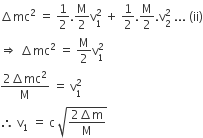Nuclei
Sponsor Area
A nuclear transformation is denoted by X(n, α)  . Which of the following is the nucleus of element X?
. Which of the following is the nucleus of element X?
B.


Sponsor Area
A nucleus disintegrates into two nuclear parts which have their velocities in the ratio 2:1. The ratio of their nuclear sizes will be
-
21/3:1
-
1:31/2
-
31/2:1
-
1:21/3
B.
1:31/2
Law of conservation of momentum gives
m1 v1 = m2 v2
A nucleus of mass M + Δm is at rest and decays into two daughter nuclei of equal mass M/2 each. Speed of light is c.
The speed of daughter nuclei is
B.

Conserving the momentum
Now, from energy conservation and mass -energy equivalence
A nucleus of mass M + Δm is at rest and decays into two daughter nuclei of equal mass M/2 each. The speed of light is c.
The binding energy per nucleon for the parent nucleus is E1 and that for the daughter nuclei is E2. Then
-
E1 = 2E2
-
E2 = 2E1
-
E1 > E2
-
E2 > E1
D.
E2 > E1
After decay, the daughter nuclei will be more stable hence, binding energy per nucleon will be more than that of their parent nucleus.
A photocell is illuminated by a small bright source placed 1 m away. When the same source of light is placed 1 /2 m away, the number of electrons emitted by photocathode would
-
decrease by a factor of 4
-
increase by a factor of 4
-
decrease by a factor of 2
-
increase by a factor of 2
B.
increase by a factor of 4
Sponsor Area
Mock Test Series
Mock Test Series











